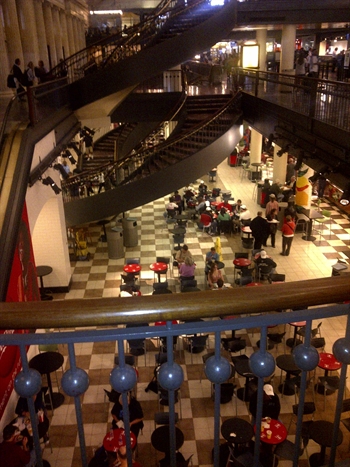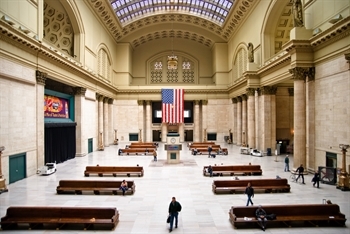
Photo: Laurence Pearlman
Published twice a month, MPC’s Talking Transit provides updates about transit-related activities around the world.
Get In the Loop on all the latest local, national, and international transit headlines. >>
Did you Know? In Illinois, inter-city ridership on Amtrak grew by 5.6 percent in 2012. This is a continuing trend: Since 2006, State of Illinois supported Amtrak ridership has increased almost 93 percent.
Growth demands
People are flocking to inter-city rail to avoid paying higher gas prices, sitting in traffic on congested highways, and stressing out at the airport. Amtrak also is meeting consumer demand with improved on-board amenities, such as Wi-Fi access and electrical outlets for mobile devices. What’s more, planned track upgrades across the country will result in faster trains. This ridership growth benefits the region by reducing traffic on the highways and emissions in the air, and by driving economic growth.
Most inter-city rail riders arrive, depart or travel through Chicago’s Union Station, the hub of Amtrak’s Midwest and long-distance routes and the nation’s third-busiest station. In addition to Amtrak riders, Union Station also serves Metra commuter rail riders, for a total of more than 15 million passengers boarding trains each year at the station. If Union Station were an airport, it would be the 10th busiest in the U.S.
In Illinois, funding from the $1.2 billion American Recovery and Reinvestment Act award is improving the Chicago-to-St. Louis rail corridor, allowing trains to travel at speeds up to 110 m.p.h.; a 15-mile stretch of the line has already been upgraded. Faster service will entice even more visitors to travel to Chicago on rail, creating a real economic opportunity: Projections show that over the next 10 years, about 800,000 new tourists will visit Chicago thanks to the Chicago-to-St. Louis modernization. The Metropolitan Planning Council (MPC) analyzed the economic impact of that increased tourism in the Chicago area and determined that the project will pay for itself in just 10 years due to increased tourism spending alone!

Overcrowding at Chicago Union Station
But Union Station is at passenger capacity and on top of projected growth in Amtrak ridership, Metra forecasts a 40 percent increase in trains by 2040 to meet growing regional transit demand. Without improvements to Union Station, the region stands to lose billions of dollars in potential economic development around the station, particularly in the growing West Loop neighborhood.
Renovated Union Station: More capacity and economic boom
The Chicago Union Station Master Plan Study – led by the Chicago Dept. of Transportation in partnership with Amtrak, Metra, and other stakeholders including MPC – has identified viable ideas for expanding capacity to add more trains at Union Station by repurposing platforms, improving passenger flow, and allowing for better connections to other transit service. These changes would suffice to address inter-city rail and Metra ridership growth, but the plan goes beyond transportation. Chicago Union Station has the potential to be much more than a place where people catch a train; it can be transformed into a truly great place that is a vibrant destination, a neighborhood and city asset, and a catalyst for economic growth. As chair of the Civic Advisory Committee for the Union Station Master Plan Study, MPC has been working to ensure a renovation of this historic structure creates a destination that attracts people to shop, dine or just hang out.

Washington, DC Union Station, with several levels of shopping and dining, is a destination for train and non-train riders alike.
Peter Skosey
Cities across the country, including Denver, Washington, D.C., and San Francisco, have shown train terminals can be focal points for commercial redevelopmentand promote new development in the surrounding area. For example, Washington, D.C.’s Union Station is a destination featuring several levels of retail and dining, a public plaza, and bike sharing facilities, in addition to connections to rail. The neighborhood surrounding it has seen incredible population, housing and business growth over the past decade.Similar to these stations, a transformed Chicago Union Station would be a catalyst for adjacent property development.

Plenty of opportunities to make Union Station's Great Hall a real destination.
random.places via flickr
Innovative financing
But how would Chicago pay for the upfront costs of renovating Union Station? The increase in property value around the station that would result from station redevelopment could be the answer. This type of innovative financing connects the benefits of an infrastructure investment with the costs to provide it. Though this type of financing is new to the Chicago region, it has been used to build and renovate transportation facilities all over the world. For example, Denver built its Union Station with an $145.6 million Transportation Infrastructure Finance and Innovation Act (TIFIA) loan and a $155 million Railroad Rehabilitation and Improvement Financing (RRIF) Loan, and will repay both with future property taxes generated in the tax increment financing district surrounding the station.
In 2013, MPC will analyze the potential to use this type of innovative financing to redevelop Chicago Union Station, an important investment that supports World Business Chicago’s Plan for Economic Growth and Jobs and Chicago Metropolitan Agency for Planning’s GO TO 2040 comprehensive regional plan.